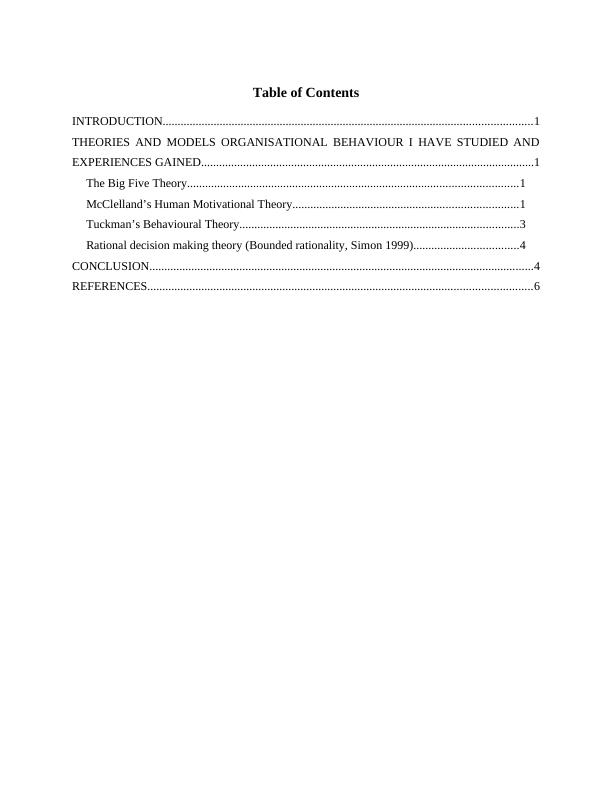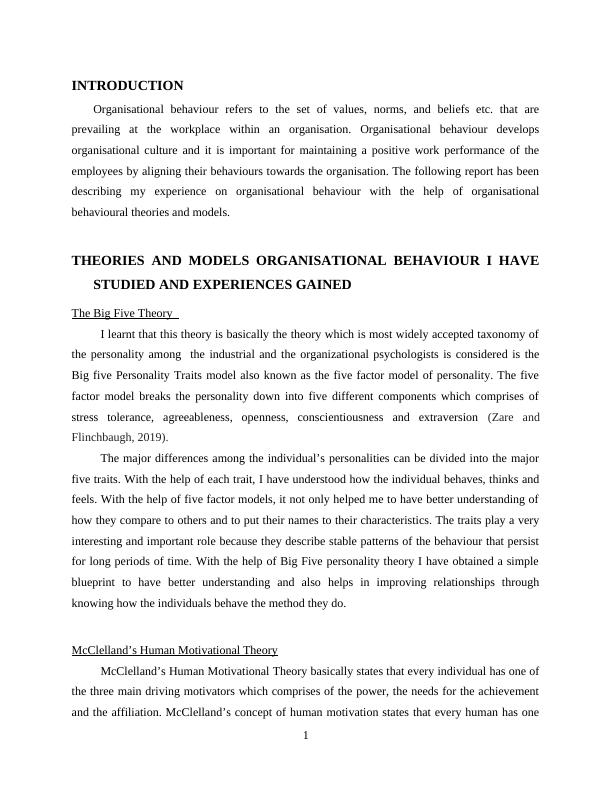Organisational Dynamics and Behaviour: Theories and Models
Added on 2023-06-10
8 Pages2126 Words160 Views
Organisational
Dynamics and
Behaviour
Dynamics and
Behaviour

Table of Contents
INTRODUCTION...........................................................................................................................1
THEORIES AND MODELS ORGANISATIONAL BEHAVIOUR I HAVE STUDIED AND
EXPERIENCES GAINED...............................................................................................................1
The Big Five Theory..............................................................................................................1
McClelland’s Human Motivational Theory...........................................................................1
Tuckman’s Behavioural Theory.............................................................................................3
Rational decision making theory (Bounded rationality, Simon 1999)...................................4
CONCLUSION................................................................................................................................4
REFERENCES................................................................................................................................6
INTRODUCTION...........................................................................................................................1
THEORIES AND MODELS ORGANISATIONAL BEHAVIOUR I HAVE STUDIED AND
EXPERIENCES GAINED...............................................................................................................1
The Big Five Theory..............................................................................................................1
McClelland’s Human Motivational Theory...........................................................................1
Tuckman’s Behavioural Theory.............................................................................................3
Rational decision making theory (Bounded rationality, Simon 1999)...................................4
CONCLUSION................................................................................................................................4
REFERENCES................................................................................................................................6

INTRODUCTION
Organisational behaviour refers to the set of values, norms, and beliefs etc. that are
prevailing at the workplace within an organisation. Organisational behaviour develops
organisational culture and it is important for maintaining a positive work performance of the
employees by aligning their behaviours towards the organisation. The following report has been
describing my experience on organisational behaviour with the help of organisational
behavioural theories and models.
THEORIES AND MODELS ORGANISATIONAL BEHAVIOUR I HAVE
STUDIED AND EXPERIENCES GAINED
The Big Five Theory
I learnt that this theory is basically the theory which is most widely accepted taxonomy of
the personality among the industrial and the organizational psychologists is considered is the
Big five Personality Traits model also known as the five factor model of personality. The five
factor model breaks the personality down into five different components which comprises of
stress tolerance, agreeableness, openness, conscientiousness and extraversion (Zare and
Flinchbaugh, 2019).
The major differences among the individual’s personalities can be divided into the major
five traits. With the help of each trait, I have understood how the individual behaves, thinks and
feels. With the help of five factor models, it not only helped me to have better understanding of
how they compare to others and to put their names to their characteristics. The traits play a very
interesting and important role because they describe stable patterns of the behaviour that persist
for long periods of time. With the help of Big Five personality theory I have obtained a simple
blueprint to have better understanding and also helps in improving relationships through
knowing how the individuals behave the method they do.
McClelland’s Human Motivational Theory
McClelland’s Human Motivational Theory basically states that every individual has one of
the three main driving motivators which comprises of the power, the needs for the achievement
and the affiliation. McClelland’s concept of human motivation states that every human has one
1
Organisational behaviour refers to the set of values, norms, and beliefs etc. that are
prevailing at the workplace within an organisation. Organisational behaviour develops
organisational culture and it is important for maintaining a positive work performance of the
employees by aligning their behaviours towards the organisation. The following report has been
describing my experience on organisational behaviour with the help of organisational
behavioural theories and models.
THEORIES AND MODELS ORGANISATIONAL BEHAVIOUR I HAVE
STUDIED AND EXPERIENCES GAINED
The Big Five Theory
I learnt that this theory is basically the theory which is most widely accepted taxonomy of
the personality among the industrial and the organizational psychologists is considered is the
Big five Personality Traits model also known as the five factor model of personality. The five
factor model breaks the personality down into five different components which comprises of
stress tolerance, agreeableness, openness, conscientiousness and extraversion (Zare and
Flinchbaugh, 2019).
The major differences among the individual’s personalities can be divided into the major
five traits. With the help of each trait, I have understood how the individual behaves, thinks and
feels. With the help of five factor models, it not only helped me to have better understanding of
how they compare to others and to put their names to their characteristics. The traits play a very
interesting and important role because they describe stable patterns of the behaviour that persist
for long periods of time. With the help of Big Five personality theory I have obtained a simple
blueprint to have better understanding and also helps in improving relationships through
knowing how the individuals behave the method they do.
McClelland’s Human Motivational Theory
McClelland’s Human Motivational Theory basically states that every individual has one of
the three main driving motivators which comprises of the power, the needs for the achievement
and the affiliation. McClelland’s concept of human motivation states that every human has one
1

End of preview
Want to access all the pages? Upload your documents or become a member.
Related Documents
Context of Business Essaylg...
|8
|1569
|321
Leadership Essay - BSBWOR501lg...
|7
|2108
|60
Influence of Organisational Culture on Behaviour and Performancelg...
|20
|6135
|32
Reflective Journallg...
|7
|1618
|287
Organisational Behaviourlg...
|9
|1018
|100
Organizational Behaviour: McClelland and Maslow's Theorylg...
|10
|2610
|1
